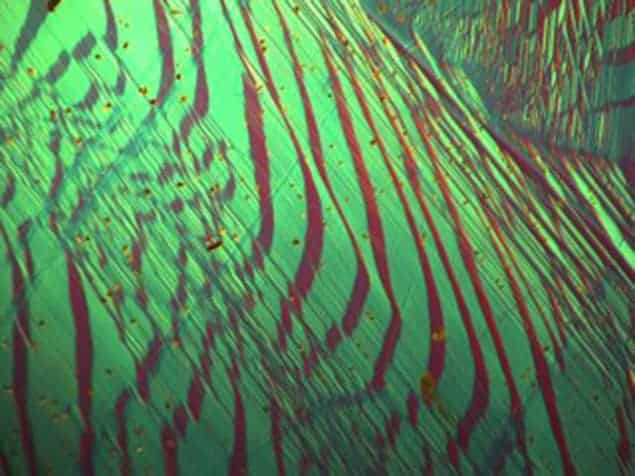
A new material that once deformed will automatically return to its original shape when heated has been developed by researchers in the US. While this is not the first such “shape-memory metal”, the latest material can go through 16,000 shape-shifting cycles without significant degradation – making it far more robust than existing materials. The metal was created using a theoretical model that predicts which types of materials should have superior shape-memory properties. The team believes its model will lead to the creation of new types of materials that could have a range of technological applications.
Shape-memory alloys are reversible phase-change materials that can exist in two crystal-lattice structures: one that is more stable above a certain transition temperature and the other favoured at lower temperatures. If the material is cooled through the transition temperature, the lattice reconfigures itself to the low-temperature structure. If it is then heated above the transition temperature, it reverts back to the high-temperature structure.
Deforming a shape-memory metal in the low-temperature phase produces a distorted version of the low-temperature lattice structure. When heated, this distorted low-temperature lattice cannot directly reconfigure itself into the high-temperature version. Instead, the metal reverts to its original shape, which allows it to adopt the high-temperature crystal structure. Applications for these materials include temperature-sensitive switches and guide wires used in catheters.
Highly stressed phase
Traditional phase-change materials undergo this shape change by passing through a highly stressed intermediate phase that introduces cracks and dislocations into the material. As this damage builds up, the shape-shifting abilities of the material degrade and sometimes the material can lose strength and fail altogether.
In 2005 Richard James and Zhiyong Zhang at the University of Minnesota outlined a set of theoretical requirements for a phase-change material to be free of this stressed transition state. If material could be made with these desired “cofactor conditions”, its structural phase could be flipped repeatedly without damaging the material.
Now, James and colleagues have designed and manufactured such a material. They began with a known shape-memory material – the alloy Zn2AuCu – and used computer modelling to find candidate alloys with slightly different proportions of zinc, gold and copper that would better satisfy the cofactor conditions. When they had arrived at their three best candidates, they prepared the alloys in the lab to see which one had the best properties.
Unpredictable array of structures
The researchers found that one of the candidates – Zn45Au30Cu25 – satisfied the theoretical requirements almost perfectly. Furthermore, the team found that the material could be put through 16,000 hot and cold cycles without any damage to its phase-change properties. On the atomic scale, the researchers found that, whereas traditional phase-change materials return to the same, increasingly imperfect, lattice structure every time the material is cooled, the lattice of their material was a complex, unpredictable array of different structures that was reset every time the material cooled through the transition temperature. This verifies a prediction made in 2007 by James and colleagues that multiple lattice structures would be possible in a material that satisfied the cofactor conditions. The meandering domain boundaries between areas of different lattice structure led the researchers to jokingly christen the new structure “riverine”.
This latest research is reported in Nature and the paper simply deals with the preservation of phase-change properties over a large number of cycles. However, James told physicsworld.com that his team has also established that the shape-memory effect is preserved as well. The researchers are also looking for other examples of phase-change materials that satisfy the cofactor conditions. “We would love to try this on a ceramic system where it would be really unexpected to have this reversibility of a big first-order phase transformation,” he says.
New generation of alloys
Ryusoke Kainuma from Tohuku University in Japan, an expert on shape-memory metals, believes that the paper “opens the door to a new generation of shape-memory alloys”, although he suggests that the difficulty of manufacturing the Zn45Au30Cu25 alloy together with the high cost of gold is likely to rule out any direct industrial application.
Meanwhile, materials physicist James Morris of the Oak Ridge National Laboratory in Tennessee is most impressed by the unconventional way that the researchers have used abstract concepts to design a real material. “Without saying what the degradation mechanisms are and without looking at the structures of the interfaces, they’ve said ‘this geometrical thing should minimize the stress that leads to degradation, and so we’re going to try that’,” he says. “And it looks reasonably convincing.”



